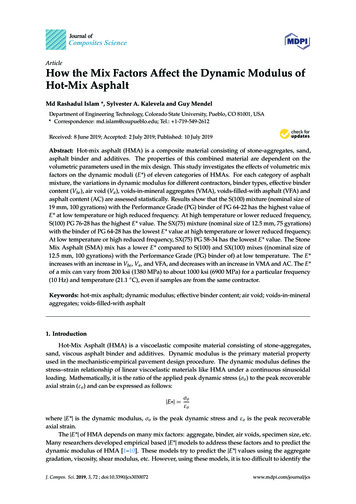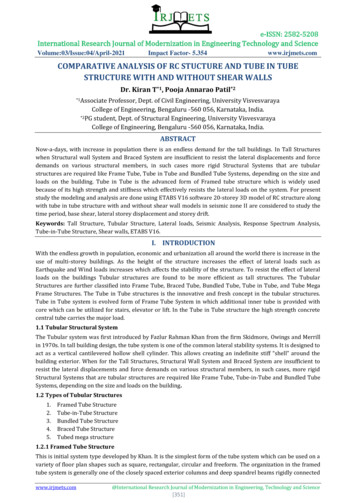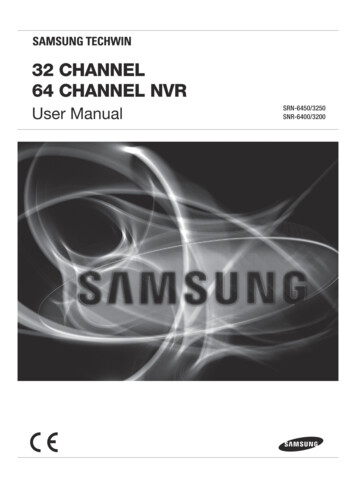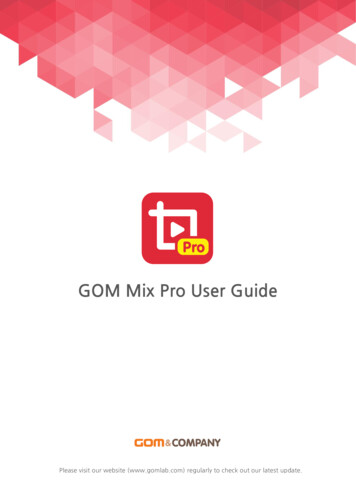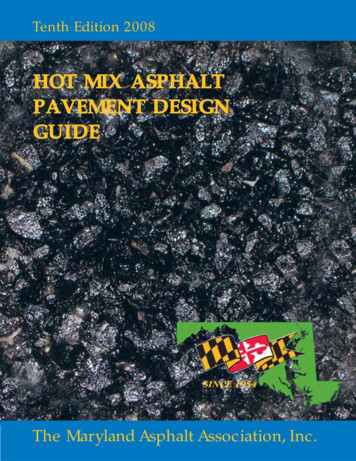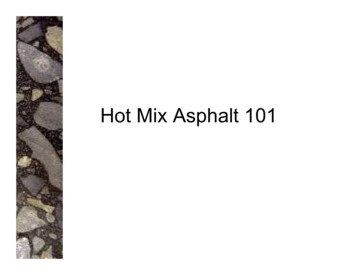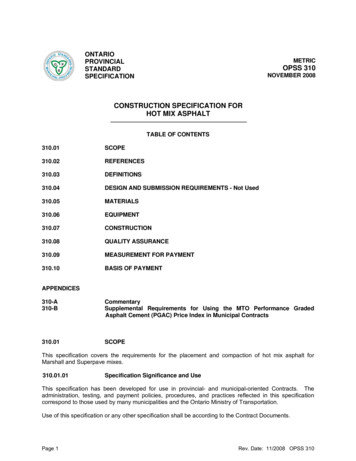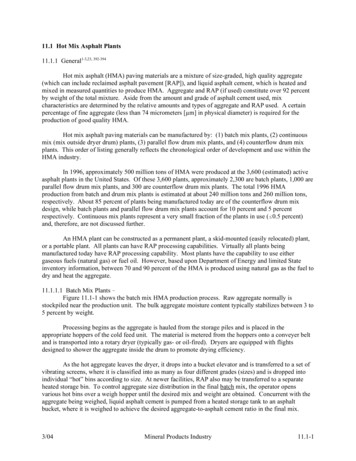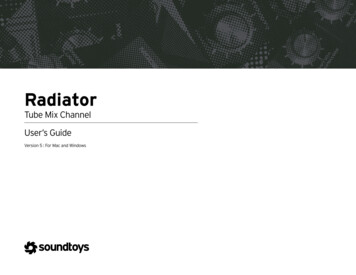
Transcription
RadiatorTube Mix ChannelUser’s GuideVersion 5 : For Mac and Windows
CONTENTS (continued)PhaseMistressRadiator — Version 5THE BASICS / Pg. 3About Radiator . . pg. 4THE RADIATOR CONTROL PANEL / Pg. 5Radiator’s Circuit . pg. 5Input . pg. 6Mic / Line Switch . pg. 6Noisy / Clean Switch . pg. 7Bass . . pg. 7Treble . . pg. 8Output . pg. 8Mix . pg. 9Heat Meter . pg. 9ADDITIONAL INFORMATION / Pg. 10Support / Contact. pg. 10soundtoys.com2
THE BASICSRadiator — Version 5Figure 1: Radiator’s Control Panelsoundtoys.com3
THE BASICS - ABOUT RADIATORRadiator — Version 5Warmth: it’s the elusive and hard to quantify character that we’re alland punchy 1567A to be a sleeper classic for injecting that nebulousstriving for in modern, digital productions. Radiator was designed forconcept of “warmth” we mentioned earlier. With bands like the Blackthis very task, turning up the HEAT on your mixes, based off of one ofKeys (who had a custom console made from Altec 1567As) utilizingthe warmest devices we know of: the Altec 1567A Mixer Amplifier.these little pieces of studio history the demand, and price, for thesefunky little color boxes have soared.The original Altec 1567A hardware, introduced in the early 1960s, was arack-mounted five-input tube mixer. It featured removable transformers,Radiator brings the heat-generating properties of the 1567A to youra simple two-knob EQ, and a whopping 97 dB of gain, all behind andigital setup with more options and flexibility versus the original units.unmistakable and very green faceplate.In addition to being a faithful recreation of the saturation and harmonicproperties of the original hardware (based on multiple 1567A andAltec gear, specifically the 1566A (off of which Radiator’s younger1566A units at Soundtoys HQ), Radiator accurately models the bass andsibling, Little Radiator is based) and the larger 1567A played a big parttreble tone controls from the original unit. A mix control is added forin shaping the sound of Motown between 1961 and 1964. Songs by greatseasy parallel processing as well as a selectable Mic/Line mode switchlike The Four Tops, The Marvelettes and The Supremes all went throughmirroring the 1567A’s extremely level-dependent frequency response.the five-channel 1567A located in the control room at Motown Studio A.With Radiator you can bring classic tube warmth to every inputBy today’s standards, the sound of the Altec is colored and gritty, withchannel and every bus, without the hassle of procuring collector-priceda generous amount old-fashioned hardware noise. The EQ was about ashardware. Radiator and Little Radiator are the prefect tools to crank upsimple as it gets, one knob for Bass, another for Treble. As the recordingthe heat on your mixes.industry chased ever-increasing fidelity through the ‘60s and ‘70s,these now rather antiquated tube mixers found themselves replacedwith more feature-rich, transistor-based consoles by manufacturerssuch as Neve and API. A lot of 1567A’s found their way into the PA racksof churches and school auditoriums across the USA.Eventually, aficionados of the analog sound began seeking out the1566A and 1567A as inexpensive sources for a real-life tube front end.Producers like Matt Wallace, Butch Vig, and Billy Bush found the warmsoundtoys.com4
THE RADIATOR CONTROL PANELRadiator — Version 5Figure 2: Radiator’s Control PanelRADIATOR’S CIRCUITThe clean input signal given to Radiator is fed into the first tubeBefore we discuss Radiator’s controls it is beneficial to mention the pathsaturation stage with the drive level determined by the input control.that audio takes as it flows through Radiator. The signal path of RadiatorFrom the first stage output, the signal then flows into a 2-band EQmatches that of the original Altec 1567A hardware and respondssection with Bass and Treble controls. After the tone stack, the signalaccordingly. Unlike the original circuit however, Radiator features areaches the second saturation stage. This is controlled by the frontmodern Wet/Dry, control giving the option to balance affected soundpanel’s Output knob. Finally, the processed signal is fed into one channelwith original audio - whereas the output of the hardware would beof the Wet/Dry mixer.equivalent only to 100% processed (wet) audio.soundtoys.com5
THE RADIATOR CONTROL PANELRadiator — Version 5INPUTMIC / LINE SWITCHThe input control of Radiator determines the gain of the signal enteringA source selection switch, labeled Line and Mic, is included on the frontRadiator’s (virtual) circuit path. As gain is increased, saturationpanel. The Altec 1567A has a very impedance dependent response inwill increase accordingly along with output level. The Input controlregards to the input, which we included while building Radiator. The Micdetermines the amount of drive into the first tube saturation stage. Theand Line modes represent the differences in behavior observed with adrive level from the Input control is then fed into the tone stack section150ohm impedance (Mic) vs. 600ohm (Line) signal.of Radiator.Figure 3 shows the overall frequency response differences as theyrelate to source selection.Figure 3: Mic/Line Frequency Responsesoundtoys.com6
THE RADIATOR CONTROL PANELRadiator — Version 5NOISY / CLEAN SWITCHThe 1567A has a significant amount of circuit noise even at lowsaturation levels, and this noise was modeled and included in Radiator. Itaverages -68dBu at the maximum measured settings, and is reduced by10dB with the “Line” source selected. However this circuit noise can becompletely suppressed by selecting “Clean” using the front panel Clean/Noisy switch.Figures 4 and 5 show a 0dBFS (18dBu) 1kHz sine wave processedthrough both Radiator (with Line selected) and the 1567A. The FFT plotshows the 20dB difference in the noise floor as well as the first throughtenth harmonics.Figure 5: Altec 1567A Waveshape and FFTBASSRadiator includes a two-band EQ section which is post-input stage andpre-output stage. Both the Bass and Treble controls allow for a /-10dBboost/cut. The “0” value of the Bass and Treble controls are at the 12o’clock position with a clockwise motion used to increase the value anda counter-clockwise motion used to decrease the value.Figure 6 on the next page shows the frequency responses, ranging fromFigure 4: Radiator Waveshape and FFTsoundtoys.com10Hz to 24kHz, for the minimum and maximum gain of the Bass control.7
THE RADIATOR CONTROL PANELRadiator — Version 5BASS (continued)gain of the Treble control. The frequency response behavior for theThe frequency response behavior mirrors that of the original 1567A withTreble control also mirrors the operation of the original control on thea wide curve for bass frequency cut and more of a sloping boost.hardware 1567A.Figure 6: Bass Frequency ResponseFigure 7: Treble Frequency ResponseTREBLEOUTPUTThe Treble control works similarly to the Bass control. The “0” value ofThe Output control determines the audio level coming out of Radiator.the Treble control is at the 12 o’clock position with a clockwise motionThis control is useful not only for adjusting the level of the signal inused to increase the value and a counter-clockwise motion used toyour mix but also to compensate for any increase in level from usingdecrease the value. A /-10db boost/cut is available with this control.the Input control to increase the level going into the first stage of tubeFigure 8 shows the frequency responses for the minimum and maximumsaturation.soundtoys.com8
THE RADIATOR CONTROL PANELRadiator — Version 5OUTPUT (continued)HEAT METERKeep in mind that this control determines the level of post-tone stackThe Radiator front panel also includes a specialized VU-style meteraudio entering the second stage of saturation before being fed intobased on the aesthetics of the 1567A which displays the “HEAT”the wet/dry mix. This means that, true to the original unit, additionalamount. The HEAT meter is calibrated to the 1567A VU meter settingssaturation of the signal can be achieved through boosting the output.meaning that Radiator and the 1567A have the same output level andHowever, as this control also determines output level, adjusting thesaturation characteristics.level of the track in your host application (or with a trim plug-in) may benecessary at extreme output settings.MIXOne major addition to Radiator vs. the original hardware is the Mixcontrol. This allows the unprocessed (dry) signal to be mixed in withthe processed (wet) signal. The 0% to 100% range corresponds to theoutput level percentage of the processed audio. The Mix control allowsfor parallel processing to occur directly within Radiator without theneed for external bussing.soundtoys.comFigure 8: The Heat Meter - Turn it up!9
ADDITIONAL INFORMATIONRadiator — Version 5SUPPORT INFORMATIONNow that you’ve taken the time to learn all about Radiator, have fun,experiment, and make greatness! If our plug-ins helped you take yourproduction to the next level, let us know, we’d love to hear from youand what you were able to create with our software.If along the way however you should run into any hiccups or anythingunexpected, we offer free technical support for all registered users.Our FAQ contains many helpful answers. you can find it at:http://support.soundtoys.comIf you need further support you can find our Customer Supportcontact form at:Please have the following information available to help assist oursupport team: The product version and serial number The version number of your audio system (e.g ProTools11.2.1, Cubase 8.0.5, Logic 10.2.0, Cakewalk Sonar X3) Your interface/hardware (e.g. Mbox Pro, Apogee Quartet,RME Fireface, etc.) Your computer and operating system info (e.g. MacPro OS X10.9.5, Windows 7 SP1, Windows 8.1, etc.) A detailed description of the ORATE CONTACTYou can also reach our support staff by e-mail at:support@soundtoys.comSoundtoys, Inc.PO Box 528If neither of those options work for you, our office can be reached viaBurlington, VT 05402telephone at:Phone: 802-951-97001-800-COOL-EFXsoundtoys.comFax: 802-951-979910
Radiator — Version 5Wave Mechanics, Soundtoys, Crystallizer, EchoBoy, FilterFreak, PhaseMistress, PitchDoctor,PurePitch, SoundBlender, Speed, Decapitator, PanMan, Tremolator, Devil-Loc, Radiator,MicroShift, PrimalTap, and their respective logos are all trademarks of Soundtoys, Inc.All other trademarks are the property of their respective owners, which are in no wayassociated or affiliated with Soundtoys. These trademarks are used only for historicalreference or to identify products whose sounds or tone were studied in the developmentof our plug-ins. 2015 Soundtoys Inc. All rights reserved.
User’ sGUuisd 5 THE RADIATOR CONTROL PANEL Radiator — Version 5 Figure 2: Radiator’s Control Panel Before we discuss Radiator’s controls it is beneficial to mention the path that audio takes as it flows through Radiator.
